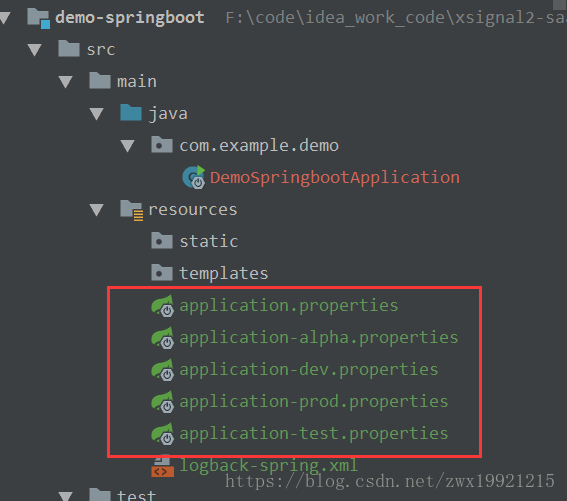- ubuntu12.04环境下使用kvm ioctl接口实现最简单的虚拟机
- Ubuntu 通过无线网络安装Ubuntu Server启动系统后连接无线网络的方法
- 在Ubuntu上搭建网桥的方法
- ubuntu 虚拟机上网方式及相关配置详解
CFSDN坚持开源创造价值,我们致力于搭建一个资源共享平台,让每一个IT人在这里找到属于你的精彩世界.
这篇CFSDN的博客文章springboot 多环境配置教程由作者收集整理,如果你对这篇文章有兴趣,记得点赞哟.
在上一课中我们通过idea工具没有做任何配置就构建了一个springboot项目,并且已经成功启动了,但我们都很清楚这些都远远不能达到我们实际项目的需求,比如我们要引入我们自己的redis配置、mysql配置等,应该如何处理呢?在spring mvc中我们都是通过spring.xml相关文件配置,在springboot中这些都已经不存在了,我们应该怎样配置呢?别急,马上为大家揭晓谜底,跟着我一起来吧! 。
no1.我们在做项目的时候是不是都会区分很多环境呢?比如开发环境、测试环境、生产环境等,那么第一步我将先带大家配置好各个环境; 。
1.首先打开我们项目的pom.xml文件加入以下内容:
|
1
2
3
4
5
6
7
8
9
10
11
12
13
14
15
16
17
18
19
20
21
22
23
24
25
26
27
28
29
30
31
32
33
34
35
36
37
38
39
40
41
42
43
44
45
46
47
48
49
50
51
52
53
54
55
56
57
58
59
60
61
62
63
64
65
66
67
68
69
70
71
72
73
74
75
76
77
78
79
|
<build>
<finalname>${project.artifactid}-${project.version}</finalname>
<plugins>
<plugin>
<groupid>org.springframework.boot</groupid>
<artifactid>spring-boot-maven-plugin</artifactid>
<executions>
<execution>
<goals>
<goal>repackage</goal>
</goals>
</execution>
</executions>
</plugin>
<plugin>
<groupid>org.apache.maven.plugins</groupid>
<artifactid>maven-compiler-plugin</artifactid>
<version>
3.3
</version>
<configuration>
<source>
1.8
</source>
<target>
1.8
</target>
<encoding>utf8</encoding>
</configuration>
</plugin>
</plugins>
<filters>
<filter>src/main/resources/application-${filter-resource-name}.properties</filter>
</filters>
<resources>
<resource>
<directory>src/main/resources</directory>
<filtering>
true
</filtering>
<excludes>
<exclude>filters/*</exclude>
<exclude>filters/*</exclude>
<exclude>application-dev.properties</exclude>
<exclude>application-test.properties</exclude>
<exclude>application-alpha.properties</exclude>
<exclude>application-prod.properties</exclude>
</excludes>
</resource>
<resource>
<directory>src/main/resources</directory>
<filtering>
true
</filtering>
<includes>
<include>application-${filter-resource-name}.properties</include>
</includes>
</resource>
</resources>
</build>
<profiles>
<profile>
<id>dev</id>
<activation>
<activebydefault>
true
</activebydefault>
</activation>
<properties>
<filter-resource-name>dev</filter-resource-name>
</properties>
</profile>
<profile>
<id>test</id>
<properties>
<filter-resource-name>test</filter-resource-name>
</properties>
</profile>
<profile>
<id>alpha</id>
<properties>
<filter-resource-name>alpha</filter-resource-name>
</properties>
</profile>
<profile>
<id>prod</id>
<properties>
<filter-resource-name>prod</filter-resource-name>
</properties>
</profile>
</profiles>
|
这一段相信大家都很熟悉了吧,我就不多做解释了(有疑问的童鞋可以私信我哦); 。
2.然后打开application.properties文件,并在其中加入以下内容:
#表示激活的配置文件(dev|prod) spring.profiles.active=@filter-resource-name@ 。
整个项目变成了如下结构:

至此我们的springboot多环境配置已经完成; 。
3.设置日志级别 。
|
1
2
|
#log level
logging.level.root=debug
|
4.设置自定义端口以及实例名 。
|
1
2
3
4
|
#端口
server.port=
8888
#实例名
spring.application.name=demo-springboot
|
5.logback-spring.xml 。
|
1
2
3
4
5
6
7
8
9
10
11
12
13
14
15
16
17
18
19
20
21
22
23
24
25
26
27
28
29
30
|
<?xml version=
"1.0"
encoding=
"utf-8"
?>
<configuration>
<include resource=
"org/springframework/boot/logging/logback/base.xml"
/>
<appender name=
"demo"
class
=
"ch.qos.logback.core.rolling.rollingfileappender"
>
<file>demo/demo.log</file>
<rollingpolicy
class
=
"ch.qos.logback.core.rolling.timebasedrollingpolicy"
>
<!-- 按天回滚 daily -->
<filenamepattern>demo/demo.%d{yyyy-mm-dd}.log</filenamepattern>
<!-- 日志最大的历史
10
天 -->
<maxhistory>
10
</maxhistory>
</rollingpolicy>
<encoder charset=
"utf-8"
>
<pattern>${file_log_pattern}</pattern>
</encoder>
</appender>
<logger name=
"com.example.demo"
level=
"info"
additivity=
"false"
>
<appender-ref ref=
"demo"
/>
</logger>
<logger name=
"com.example.demo.dao"
level=
"debug"
/>
<logger name=
"com.example.demo.service"
level=
"info"
/>
<logger name=
"druid.sql.statement"
level=
"debug"
/>
<logger name=
"druid.sql.resultset"
level=
"debug"
/>
<logger name=
"org.apache"
level=
"info"
/>
<logger name=
"org.mybatis.spring"
level=
"error"
/>
<logger name=
"org.springframework"
level=
"info"
></logger>
<logger name=
"springfox"
level=
"error"
></logger>
<root level=
"info"
>
<appender-ref ref=
"demo"
/>
</root>
</configuration
|
至此,我们项目的基本环境配置已经搭建好,通过maven clean install以下选择dev|test|prod打入你指定的配置,然后run application运行,如果通过localhost:8888可以访问说明你的配置worked了;但是这还远远不够,我们项目开发总得操作数据库吧,哈哈 是的,接下来让我们进入springboot + mysql + mybatis的世界吧! 。
总结 。
以上所述是小编给大家介绍的springboot 多环境配置教程,希望对大家有所帮助,如果大家有任何疑问请给我留言,小编会及时回复大家的。在此也非常感谢大家对我网站的支持! 。
原文链接:https://blog.csdn.net/zwx19921215/article/details/79786778 。
最后此篇关于springboot 多环境配置教程的文章就讲到这里了,如果你想了解更多关于springboot 多环境配置教程的内容请搜索CFSDN的文章或继续浏览相关文章,希望大家以后支持我的博客! 。
我正在做一个关于代码学院的教程,我在这里收到一个错误,说“看起来你的函数没有返回‘唉,你没有资格获得信用卡。资本主义就是这样残酷。’”当收入参数为 75 时。”但是该字符串在控制台中返回(由于某种原因
我正在阅读 Go 的官方教程,但很难理解 Channel 和 Buffered Channels 之间的区别。教程的链接是 https://tour.golang.org/concurrency/2和
就目前而言,这个问题不适合我们的问答形式。我们希望答案得到事实、引用资料或专业知识的支持,但这个问题可能会引发辩论、争论、投票或扩展讨论。如果您觉得这个问题可以改进并可能重新打开,visit the
关闭。这个问题是off-topic .它目前不接受答案。 想改进这个问题? Update the question所以它是on-topic对于堆栈溢出。 9年前关闭。 Improve this que
已关闭。此问题不符合Stack Overflow guidelines 。目前不接受答案。 要求我们推荐或查找工具、库或最喜欢的场外资源的问题对于 Stack Overflow 来说是偏离主题的,因为
作为 iOS 新手,有大量书籍可以满足学习基础知识的需求。现在,我想转向一些高级阅读,例如 OAuth 和 SQLite 以及动态 API 派生的 TableView 等。您可以推荐任何资源吗? 最佳
就目前而言,这个问题不适合我们的问答形式。我们希望答案得到事实、引用资料或专业知识的支持,但这个问题可能会引发辩论、争论、投票或扩展讨论。如果您觉得这个问题可以改进并可能重新打开,visit the
关闭。这个问题是opinion-based .它目前不接受答案。 想要改进这个问题? 更新问题,以便 editing this post 可以用事实和引用来回答它. 关闭 8 年前。 Improve
关闭。这个问题不符合Stack Overflow guidelines .它目前不接受答案。 我们不允许提问寻求书籍、工具、软件库等的推荐。您可以编辑问题,以便用事实和引用来回答。 关闭 8 年前。
前言 很多同学都知道,我们常见的CTF赛事除了解题赛之外,还有一种赛制叫AWD赛制。在这种赛制下,我们战队会拿到一个或多个服务器。服务器的连接方式通常是SSH链接,并且可能一个战队可能会同时有
Memcached是一个自由开源的,高性能,分布式内存键值对缓存系统 Memcached 是一种基于内存的key-value存储,用来存储小块的任意数据(字符串、对象),这些数据可以是数据库调用、A
Perl 又名实用报表提取语言, 是 Practical Extraction and Report Language 的缩写 Perl 是由 拉里·沃尔(Larry Wall)于19
WSDL 是 Web Services Description Language 的缩写,翻译成中文就是网络服务描述语言 WSDL 是一门基于 XML 的语言,用于描述 Web Services 以
关闭。这个问题不满足Stack Overflow guidelines .它目前不接受答案。 想改善这个问题吗?更新问题,使其成为 on-topic对于堆栈溢出。 6年前关闭。 Improve thi
我正在寻找解释在 WPF 中创建自定义用户控件的教程。 我想要一个控件,它结合了一个文本 block 、一个文本框和一个启动通用文件打开对话框的按钮。我已经完成了布局,一切都连接好了。它有效,但它是三
就目前而言,这个问题不适合我们的问答形式。我们希望答案得到事实、引用资料或专业知识的支持,但这个问题可能会引发辩论、争论、投票或扩展讨论。如果您觉得这个问题可以改进并可能重新打开,visit the
我接近 fourth page of the Django tutorial 的开始看着vote查看,最后是这样的: # Always return an HttpResponseRedirect a
就目前而言,这个问题不适合我们的问答形式。我们希望答案得到事实、引用资料或专业知识的支持,但这个问题可能会引发辩论、争论、投票或扩展讨论。如果您觉得这个问题可以改进并可能重新打开,visit the
是否有任何好的 Qt QSS 教程,或者在某个地方我可以看到样式小部件的示例?如果某处可用,我想要一些完整的引用。除了有关如何设置按钮或某些选项卡样式的小教程外,我找不到任何其他内容。 最佳答案 Qt
就目前而言,这个问题不适合我们的问答形式。我们希望答案得到事实、引用或专业知识的支持,但这个问题可能会引起辩论、争论、投票或扩展讨论。如果您觉得这个问题可以改进并可能重新打开,visit the he

我是一名优秀的程序员,十分优秀!